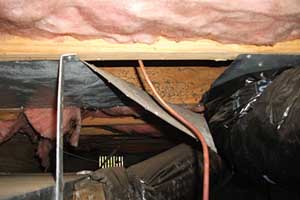
|
| David Richardson |
I’ve read in many places that updates are often made in the name of accuracy, and that is great, but is it always best?
This led me to start questioning the metrics that have been in place for residential duct leakage testing for years. Are they the most accurate metrics to use for determining duct leakage in a residential duct system? Would this be the best metric to use for quantifying duct leakage in residential duct systems?
CFM25/100ft2 CFA
CFM25/100ft² CFA is a term commonly used to express duct leakage in cfm at a 25 pascal pressure difference per 100 square foot of conditioned floor area (CFA). This value is calculated by using duct leakage airflow as measured with a duct leakage fan and comparing it against the conditioned floor area of a home. Depending on local codes, the cfm value used per 100ft² CFA is anywhere in the range of 12 cfm to 3 cfm, considering the variables that the ductwork is tested under.
There is only one problem with this. Duct leakage occurs at the surface area of the duct system, not the conditioned floor area. So, why don’t we use duct surface area instead of conditioned floor area? I have been told that CFA was chosen to keep things simple. This is the metric that is used for simplicity purposes. What about accuracy though?
CFM50/SFSA

|
| Duct leakage fans are one of the most common instruments used in determining residential duct leakage; however, some duct leaks are so obvious that you don’t need a fan to locate them. |
Building scientists are some of the sharpest people I know. One thing they know is that building leakage occurs at the surface area of a building. Otherwise, there wouldn’t be formulas for calculating this such as CFM50/SFSA. This method involves calculating how much airflow at a 50 pascal pressure difference is leaking per square foot of surface area [SFSA] of a building. The total surface area of the building enclosure is used in this method. This includes the surface area of the floor, ceiling, and all walls totaled up that separate the conditioned space from the unconditioned space. This method focuses on where air leakage in a building really occurs — the surface area of the building itself. Wouldn’t these same principles apply to a duct system? So, why don’t we use duct surface area?
Commercial Guys Already Do This
Commercial air balancers following Sheet Metal and Air Conditioning Contractors’ National Association (SMACNA) standards have been testing commercial and industrial duct systems for decades using duct surface area. The SMACNA duct leakage test typically used 3-6 inches water column (750-1,500 pascals) as the test pressure. The test pressure is typically based on fan classification and application. The metric for measurement is based on 100 square feet of duct surface area and applies to ducts only. The equipment isn’t included in the leakage calculation. Interesting, eh?
Duct Bazooka or Duct Blaster
Whenever I looked for a refrigerant leak, I didn’t pressurize the refrigeration system with nitrogen until I was close to standard non-operating system pressures. I pressurized above that to intensify the leak, making it easier to locate. Isn’t this the same thing we do with blower doors when tracking down building air leakage sites? I wonder why we don’t do this with duct systems also.
The standard for years has been 25 pascals or 0.10-inch water column. This value is said to have been chosen based on research showing this to be a typical operating pressure. I rarely find duct systems running that type of pressure in the field. The pressures were usually elevated above those levels due to undersized duct systems. This, of course, means current methods are probably underestimating leakage too, but I’ll save that for another article.
Commercial duct leakage fans designed to test duct systems operating less than 2 inches of water column generally operate at 500 pascals of pressure. This is 20 times the pressure that is currently used. Do you think you could find duct leakage easier with a fan operating at that pressure? All you would have to do is follow the whistling from the duct connections. I’m joking, but it would be easier at an amplified pressure to locate those pesky leakage sites.
Accuracy or Simplicity
If we are shooting for accuracy when it comes to quantifying and locating duct leakage, we have a long way to go from where we currently are. If we want simplicity combined with accuracy, wouldn’t it be wise to use a percentage of nominal equipment fan airflow? This would be a little closer to reality and extremely simple to calculate. We have to be careful in getting so caught up tracking down every single cfm that we don’t lose sight of the big picture of what our goals as an industry should be. There are more accurate ways to accomplish quantifying any given measure, but they might not be the best due to the excessive burden that is placed on the tester. We can’t forget the value of simplicity or there is going to be a revolution from an industry.
There also seems to be a large disconnect when it comes to the level of accuracy a builder or homeowner would be willing to pay for and what is deemed accurate testing. Is the demand for that level of accuracy really there, or is it something that has spiraled drastically out of control? I am all for accuracy in testing, but where do we draw the line between accuracy and practicality? It’s a line that we will have to define much clearer as things continue to evolve in our industry.
Publication date: 1/6/2014
Want more HVAC industry news and information? Join The NEWS on Facebook, Twitter, and LinkedIn today!



Report Abusive Comment